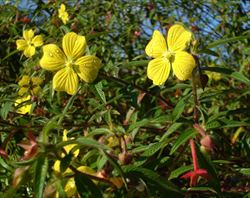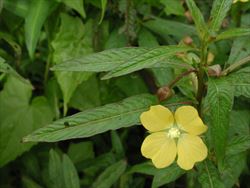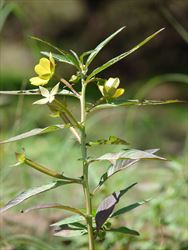Willow primrose. It is also known as false primrose, primrose willow, yellow willow herb, Mexican primrose-willow.
Pacific Pests, Pathogens, Weeds & Pesticides - Online edition
Pacific Pests, Pathogens, Weeds & Pesticides
Willow primrose (514)
Ludwigia octovalis. It is a member of the Onagraceae. The plant is variable and several sub-species are recognised. Identifications require confirmation by a botanist familiar with the genus.
Asia, Africa, North (Hawaii), South and Central America, the Caribbean (Jamaica), Oceania. It is recorded from Australia, American Samoa, Northern Mariana Islands, Cook Islands, Federated States of Micronesia, Fiji, French Polynesia, Kiribati, Marshall Islands, Nauru, New Caledonia, Palau, Papua New Guinea, Samoa, Solomon Islands, Tonga, Tuvalu, Vanuatu, and Wallis and Futuna.
An annual or perennial invasive weed of wet and waterlogged soils, fast growing, found along streams, edges of ponds, in marshes, swamps, and ditches (Photo 1). Roots develop from lower nodes of the stems, forming mats. Often, a common weed of cultivated areas where soils have abundant moisture, and occurring in coconut and sugarcane plantations, pastures, and along roadsides. It is a weed of rice, thriving where nitrogenous fertilisers have been applied. From coastal areas to 1500 masl.
Stems hairy, green or reddish-brown, up to 3 m high, sometimes woody at the base, becoming shrubby. Leaves, alternate along the stems, spear-shaped to oval (2-15 cm long, 4-40 mm wide), hairy on both sides, and with short stalks (up to 20 mm) (Photo 2). Flowers from upper axils between stem and leaf, or terminal, i.e., at the end of stems. Each flower has four yellow oval petals (10-20 mm long), narrowing to a thin stalk at the base where attached; there are four green, leaf-like sepals beneath each flower (Photos 2&3). There are eight stamens (male parts). Fruits are 20-45 mm long, brown, ribbed, with sepals attached, cylindrical, tapering towards the base, and containing many small (0.75 mm or less) beaked seeds (Photo 3).
Spread over short distances by roots from stems. Long distances by seed, possibly floating in water, and in mud stuck to machinery, vehicles, footwear.
In Fiji, a weed of taro and cassava. In Southeast Asia, CABI mentions Ludwigia octovalvis as a major weed of transplanted rice (Indonesia, India, Malaysia, Philippines, Sri Lanka, Thailand, Vietnam) and of upland rice (Indonesia, Philippines, Nepal). Worldwide, it is said to be fourth in importance among 350 broadleafed weeds of rice. It has been reported as a weed of soybean (Philippines), cocoa (Brazil), and pasture (South Pacific).
Used as a remedy for a number of medical conditions. Known to relieve sufferers of flatulence, taken as a laxative, and used to treat parasitic worms, diarrhoea and dysentery. It is cultivated as an aquatic plant.
BIOSECURITY
Ludwigia octovalvis has a very wide distribution in the tropics so countries not yet infested are very vulnerable to its introduction. Consequently, they should consider all likely pathways for entry, and apply quarantine measures accordingly. Particular attention should be given to the ease with which the plant is sought for use in traditional medicines, as a cultivated garden plant, and the fact that seed could be sent across international borders. Seed is available for purchase on the Internet.
BIOCONTROL
No information of successful management.
CULTURAL CONTROL
- Physical & Mechanical:
- Hand weeding is effective on small areas where follow-up is possible to control seedlings. Best to begin when plants are young, before seed production.
- Slashing is effective in order to encourage less-invasive species. It will need to be done regularly.
- Solarisation, using clear polythene sheets has been tried experimentally in Samoa, and found to be effective.
- Hygiene:
- Treat vehicles and farm machinery. If moving from areas where the weed occurs to those weed-free, wash to remove soil and seed. This is equally important if the machinery is being imported into a country or moved within a country.
CHEMICAL
In Australia, glyphosate is registered to spot-spray other Ludwigia species (e.g., long-leafed willow primrose and water primrose) in semi-aquatic and aquatic situations, under minor-use permits. It should be equally effective against willow primrose. In Fiji, a number of recommendations have been made, including: glyphosate, 2,4-D, dicamba, MCPA.
--------------------
Note, EU approval to use glyphosate ends in December 2022; its use after that date is under discussion.
____________________
When using a pesticide, always wear protective clothing and follow the instructions on the product label, such as dosage, timing of application, and pre-harvest interval. Recommendations will vary with the crop and system of cultivation. Expert advice on the most appropriate herbicides to use should always be sought from local agricultural authorities.
AUTHORS Grahame Jackson & Makereta Ranadi
Information from CABI (2015) Ludwigia octovalvis (primrose willow). Invasive Species Compendium. (https://www.cabi.org/isc/datasheet/31671); and Ludwigia octovalvis (Jacq.) P.H. Raven. PlantNET. New South Wales Flora Online. Australian National Botanic Gardens. (https://plantnet.rbgsyd.nsw.gov.au/cgi-bin/NSWfl.pl?page=nswfl&lvl=sp&name=Ludwigia~octovalvis); and Fern K (2021) Ludwigia octovalvis (Jacq.) R.H. Raven. Tropical Plants Database. (https://tropical.theferns.info/viewtropical.php?id=Ludwigia+octovalvis); and from Ludwigia octovalvis (2021) Wikipedia. (https://en.wikipedia.org/wiki/Ludwigia_octovalvis). Photo 1 Tau'olunga (2007) Ludwigia octovalvis, (loaano) in a Tongan swamp. (https://commons.wikimedia.org/wiki/File:Ludwigia_octovalvis5.jpg). Photo 2 Gerald McCormack. Cook Islands biodiversity. (http://cookislands.bishopmuseum.org/). Photo 3 Forest and Kim Starr. Ludwigia octovalvis (flowers and leaves). Location: Maui, Kanaha Beach. (https://commons.wikimedia.org/wiki/File:Starr_070413-6937_Ludwigia_octovalvis.jpg).
Produced with support from the Australian Centre for International Agricultural Research under project HORT/2016/185: Responding to emerging pest and disease threats to horticulture in the Pacific islands, implemented by the University of Queensland, in association with the Pacific Community and Koronivia Research Station, Ministry of Agriculture, Fiji.






